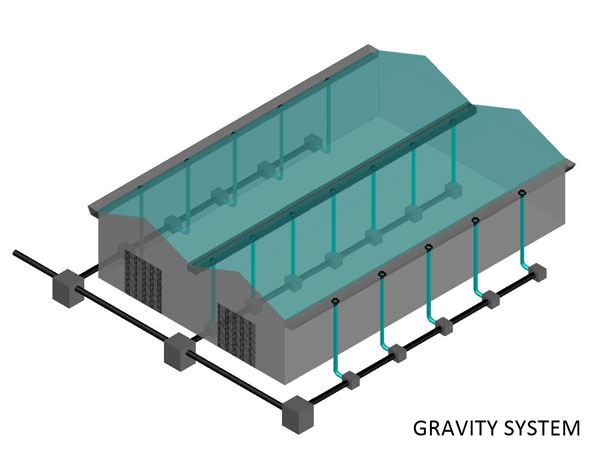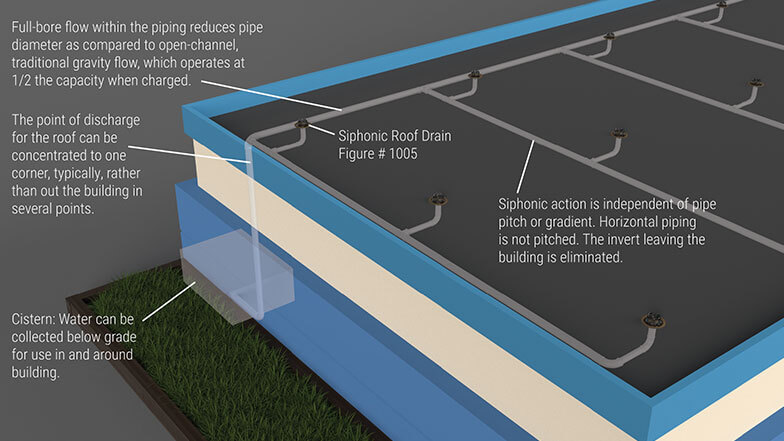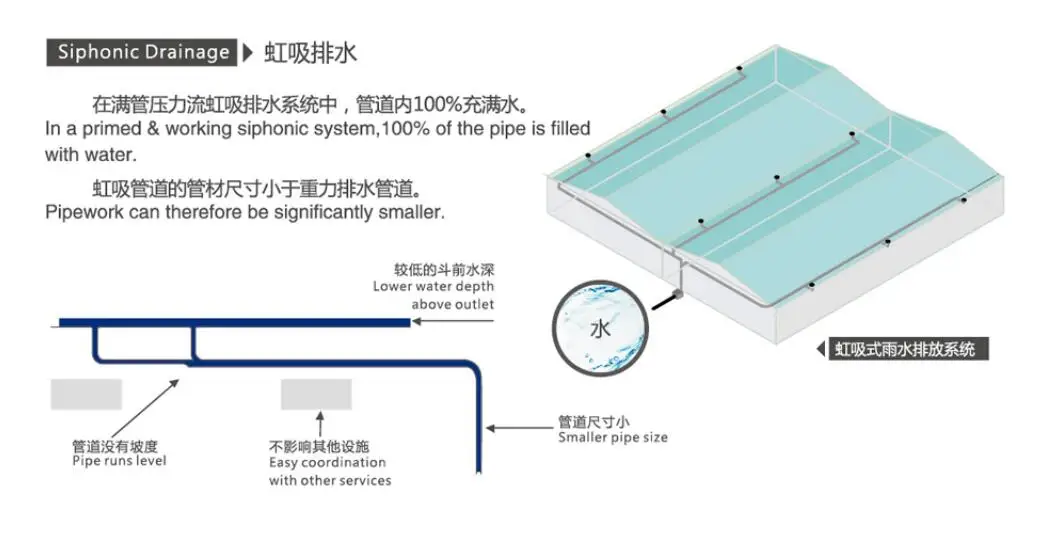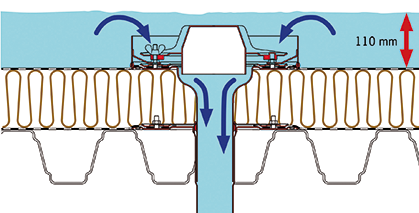Siphonic Roof Drainage System
Siphonic roof drainage system. System principles and how it differs from a conventional gravity based system. The water damming height around the outlet should be controlled through accurate calculation of drainage capacity and pipe dimension which should better be no more than 55mm. An Overview of Siphonic Roof Drainage Systems All roof drainage systems have three main elements in common beyond the fact that they all use pipes to convey the water.
In principle syphonic drainage is a very simple process. During this time siphonic systems have been extensively specified and developed and are a modern highly efficient alternative to conventional systems. By contrast a fully-engineered siphonic roof drainage system contains an anti-vortex plate that acts as a baffle and prevents air and debris from entering the piping system at full flow allowing the pipes to completely fill up with water.
Syphonic roof drainage system should use outlets tested by hydraulic method. The principle of siphonic roof drainage was first developed by the Finnish engineer Ovali Ebeling in the late 1960s. Siphonic Roof Drainage Systems JAS Siphonic A siphonic roof drainage system differs from a gravity system in two main ways.
What is siphonic roof drainage. Anticipated development of rainfall and roof drainage with marked limits for different flow patterns. What is a siphonic system.
Syphonic drainage systems operate with specially designed flat roof drains which unlike gravity drainage systems are configured to work with completely full pipes degree of fill hd 10. With siphonic roof drains are the same as those required for traditional drainage systems. This means that increased drainage performance level can be achieved compared to simple gravity drainage.
A siphonic roof drainage system will only operate efficiently at its design condition for the specified rainfall criteria used for design purposes which means the system will rarely operate optimally. The water is sucked or siphoned from the roof down into the drain at high velocity. Second the rainwater pipes are designed to run full-bored from gutter level to downpipe.
The most technically advanced siphonic roof drainage system Plumbing engineers architects building owners and contractors are increasingly realizing the many benefits of using siphonic roof drainage. Unlike traditional roof drainage systems a siphonic system is designed to operate with the piping completely charged with water during a rainstorm.
Anticipated development of rainfall and roof drainage with marked limits for different flow patterns.
When rainfall intensity reaches a high level siphonic drainage system operates on the concept of full bore flow of incompressible fluid. Unlike traditional roof drainage systems a siphonic system is designed to operate with the piping completely charged with water during a rainstorm. The first major commercial installation was in conjunction with Per Sommerhein in a Swedish turbine factory in 1972. Syphonic drainage systems operate with specially designed flat roof drains which unlike gravity drainage systems are configured to work with completely full pipes degree of fill hd 10. This means that increased drainage performance level can be achieved compared to simple gravity drainage. In principle syphonic drainage is a very simple process. With pipes as little half the size of conventional roof drainage sysems siphonic systems can reduce roof drainage costs by as much as 50 Space Savings Siphonic roof drainage systems have no slope and so can greatly ease coordination in design and in the field. When rainfall intensity reaches a high level siphonic drainage system operates on the concept of full bore flow of incompressible fluid. One or more roof drains 2.
This means that increased drainage performance level can be achieved compared to simple gravity drainage. A siphonic roof drainage system will only operate efficiently at its design condition for the specified rainfall criteria used for design purposes which means the system will rarely operate optimally. Siphonic drainage systems operate with specially designed flat roof drains which unlike gravity drainage systems are configured to work with completely full pipes degree of fill hd 10. A vertical drop from the roof level to some lower level and 3. A key feature of siphonic roof drainage systems is that they are designed to flow full bore and thereby make maximum use of the available head between roof and ground level in overcoming the flow resistance of the pipes and fittings. The water damming height around the outlet should be controlled through accurate calculation of drainage capacity and pipe dimension which should better be no more than 55mm. With pipes as little half the size of conventional roof drainage sysems siphonic systems can reduce roof drainage costs by as much as 50 Space Savings Siphonic roof drainage systems have no slope and so can greatly ease coordination in design and in the field.





































Post a Comment for "Siphonic Roof Drainage System"